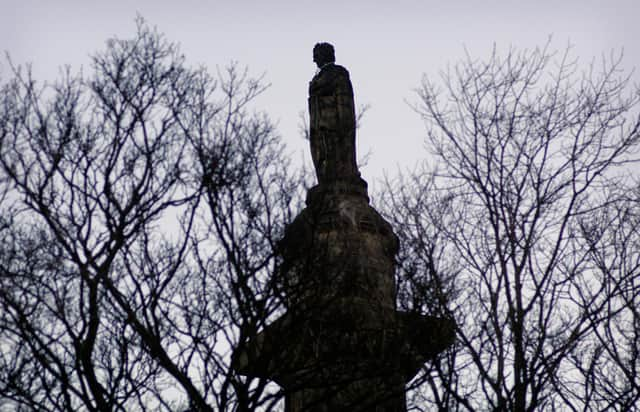Should Scotland's slave trade statues be sent to their own special park like Communism's fallen idols? – Bill Jamieson


Where do discredited statues go to die? Dozens of them face being pulled down after slave trader Edward Colston was toppled from his plinth in Bristol by an angry mob and rolled into the harbour. Councils across the UK have pledged to follow suit. And here in Scotland some of the most prominent statuary in Glasgow and Edinburgh faces removal.
There are growing demands to remove the Melville Monument in Edinburgh, erected in honour of Henry Dundas who delayed the bill for the abolition of slavery. Memorials to Glasgow’s tobacco barons are also in the frame.
Advertisement
Hide AdAdvertisement
Hide AdWhat should we do with them? And should they be replaced by statues of more contemporary political and business figures? Should we smash the old statues into pieces? Or wheel these bird-poo splattered relics into our museums? What is their fitting end?
Representatives of the Black Lives Matter movement have drawn up a list of some 60 memorials which they say should be removed because of their associations with slavery or colonialism. The name of Cecil Rhodes stands out in this list. But so too do those of Clive of India, William Gladstone and Sir Frances Drake.
Much of this statuary now – though by no means all – have little resonance in the cities where they are to be found. Many Bristolians will struggle to recall who Edward Colston was, and even fewer Londoners, I suspect, would be able to name slave owner Robert Milligan whose statue at West India docks has now been removed by Tower Hamlets council.
But the presence of these structures is seen as a chilling tribute to the manner in which their wealth was amassed – and a grievous affront.
A time-travelling phone
Here’s an idea. Some years ago on a visit to Hungary, I went to Memento Park on the outskirts of Budapest. Here is a grisly open-air museum littered with monumental statues and sculpted plaques of the country’s Communist period (1945-1989). There are statues of Lenin, Marx, Engels and assorted Hungarian communist leaders. The park is dominated by a giant pair of Stalin’s boots – all that remained of the Soviet dictator after crowds tore down his mammoth statue in the centre of Budapest in the 1956 uprising.
The site, a tourist attraction, is cluttered with some of the ghastliest Soviet statuary and concrete “social realism” artefacts. Beside the barrack-hut entrance is a phone box where you can listen to the voices of Joseph Stalin, Mao Zedong, Che Guevara and Hungarian figures from the Communist Party. “This phone cannot be used to make national or international calls, it only allows you to travel back in time,” says the sign taped up inside.
Back then these were untouchable symbols of the Soviet era – celebrations of their rank and achievements. But history is fluid. Today they are despised relics of a hated regime.
I wonder whether Memento Park could be a model for all the statues and memorials to figures linked with the slave trade currently to be found in the cities of Glasgow and Edinburgh. Many of these landmarks could be removed – the Melville Monument, and the Bute House Edinburgh and Buchanan Street Glasgow nameplates.
Salmond Wynd or Sturgeon Plaza?
Advertisement
Hide AdAdvertisement
Hide AdIt would be a marked change in our city history and iconography – all Gone with the Wind. They could be removed and taken to a windswept space far from their current prominent position – perhaps some desolate scrubland off the M8 near Shotts.
This period in our history would thus be retained – difficult to deny as much of Glasgow’s trade and wealth derived from slave-related activity: some 32 per cent of Jamaican plantations were once owned by Scots. And many of the Highland army in on Bonnie Prince Charlie’s ’45 rebellion were shipped to the West Indies as punishment to die a miserable death.
In this way, history could be, so to speak, put in its place – still there, still marked, but sited at a distance. Perhaps a visitor centre could be erected, with entrance fees donated to some appropriate charity such as scholarships for slave descendants.
However, it would leave our city centres with little clue as to their past and the figures that helped to make them. Changing street names after such a long period would be disorientating for many. We could replace them with more contemporary names and figures – Salmond Wynd, perhaps, or Sturgeon Plaza, or Blackford Close. But this would be tempting fate: how long might these memorials last as the wheel of fortune cruelly turns and clamour arises for their removal? Everything in time is Gone With the Wind.
A message from the Editor:
Thank you for reading this article on our website. While I have your attention, I also have an important request to make of you.
With the coronavirus lockdown having a major impact on many of our advertisers - and consequently the revenue we receive - we are more reliant than ever on you taking out a digital subscription.
Subscribe to scotsman.com and enjoy unlimited access to Scottish news and information online and on our app. With a digital subscription, you can read more than 5 articles, see fewer ads, enjoy faster load times, and get access to exclusive newsletters and content. Visit www.scotsman.com/subscriptions now to sign up.
Our journalism costs money and we rely on advertising, print and digital revenues to help to support them. By supporting us, we are able to support you in providing trusted, fact-checked content for this website.
Joy Yates
Editorial Director
Comments
Want to join the conversation? Please or to comment on this article.